The most faithful friend. Dogs in the service of people from antiquity to our time
Sacred dogs of the ancient Aryans
Centuries and millennia pass, but the friendship between man and dog becomes only stronger. Whether a war, a natural disaster or a riot, the protection of prisoners or the search for prohibited things at the station - everywhere dogs come to the aid of man. The business relationship between man and dog is so long that it is hardly possible to say with certainty where the first service dogs and first dog breeders appeared. Several thousand years ago, vast expanses of Eurasia - from the Black Sea steppes to the Pamir Mountains, from the Don to the Indian Ocean were inhabited by numerous tribes of ancient Aryans, who became the ancestors of not only the Indo-Aryan and Iranian peoples, but also the modern Slavs. Nomadic tribes of the ancient Aryans, engaged in cattle breeding, covered vast distances, creating sedentary settlements in which they turned to agriculture, and preserving the traditional way of life of their ancestors — tent, horses, herds of cattle, and periodically bloody clashes with competitors for pastures. . The steppes of the Northern and Northeastern Black Sea Coast were occupied by Scythian and Sarmatian tribes, which became one of the key components of the formation of the southern Russian population. Being nomadic cattle-breeders, Scythians and Sarmatians inevitably collided in the Black Sea steppes with wolves - the main predators, who threatened the herds, but caused sincere admiration for their fighting qualities. The domesticated descendants of wolves — dogs — became loyal assistants to the cattle breeders of the Black Sea steppes in protecting countless herds from steppe predators, as well as in battles with enemies. It was the wolf and the dog that was most respected by the Iranian tribes.
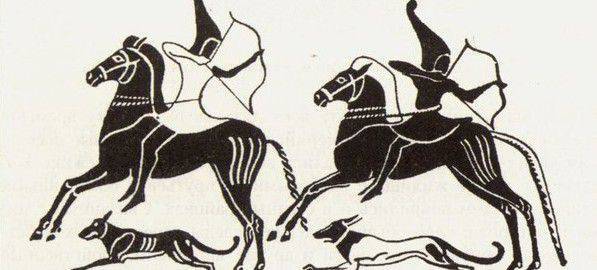
In VII - VI centuries. BC. numerous Scythian detachments under the command of the leader Ishpakaya invaded the territory of Asia Minor. On the lands of modern Iraq, the Scythians were faced with the great power of that time — powerful Assyria. However, despite the development of the armed forces, even for the Assyrian state, the onslaught of the Scythian tribes was a great and difficult test. Tsar Assarhadon turned to the oracle of the god Shamash, but he said to the sovereign: "The Scythians can expose the dog to a belligerently furious and mad." What the shamash oracle had in mind remained a mystery. It is not excluded that the Scythian leader Ishpakai himself was meant by “dog militantly furiously mad” - after all, his name dates back to the ancient Aryan word “Spaka” - “dog”. But perhaps it was about a military alliance. It is known that the existence of secret military alliances was characteristic of many archaic peoples in all parts of the world - such societies existed in Africa, Polynesia, Melanesia. West African nations had "people - leopards," and Polynesians had "people - birds." The ancient Iranians, to whom the Scythians belonged, were surrounded by the honor of "people - wolves", or "people - dogs." Traces of ancient totemism are still preserved in the legends of some North Caucasian peoples about their origin from wolves. After all, the wolf has always symbolized in the cultural space of the Iranian and neighboring peoples valor, bravery, strength and ferocity.
The "people-dogs" of the ancient Scythians were precisely members of a secret male union, for which the dog was a totem animal. When the "people - dogs" had to fight, and they often did it, they fell into a trance state and presented themselves as fighting dogs, turning into indomitable warriors. During the excavations on the territory of the Black Sea steppes, as well as in the Caucasus and the countries of Western Asia, domestic and foreign archaeologists repeatedly found bronze plaques depicting a dog - they were put into the grave together with the owners - the late Scythian warriors. In addition to the bronze images of dogs, dog skeletons were also repeatedly found in Scythian kurgans. Approximately to the end of the 4th c. BC. Dogs were buried only with representatives of the Scythian military nobility. To commoners, the presence of a “faithful friend” in the grave was not supposed. However, later, as dog breeding spread among the Scythians, the custom of burial of a dog in the grave of a Scythian male warrior extends to the common people of the dead. Apparently, the ancient Scythian dogs were the ancestors of the hound's horns — the very long-legged and sleek-haired dogs that the ancient Greeks often painted on the images of the hunt of the Amazons — Sarmatian women — warriors.
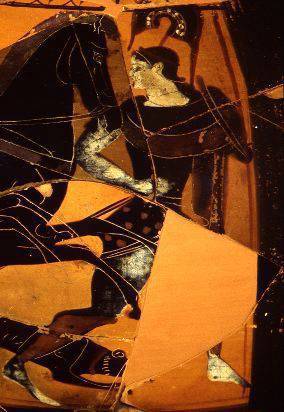 By the way, the Sarmatians and their direct descendants, the Alans, had their own dog breed - large dog-shaped dogs, which most likely had to do with the ancient mastiffs and mastiffs of Central Asia. In the first years of our era, the Alans invaded Europe and actually passed it entirely, settling on the Iberian Peninsula. Only in France, up to the present, at least three hundred geographical names of Alanian origin are preserved, and they are also in Spain. Naturally, along with the Alanian tribes, their fierce dogs appeared on the territory of Europe, being loyal assistants to their masters in numerous fighting clashes.
By the way, the Sarmatians and their direct descendants, the Alans, had their own dog breed - large dog-shaped dogs, which most likely had to do with the ancient mastiffs and mastiffs of Central Asia. In the first years of our era, the Alans invaded Europe and actually passed it entirely, settling on the Iberian Peninsula. Only in France, up to the present, at least three hundred geographical names of Alanian origin are preserved, and they are also in Spain. Naturally, along with the Alanian tribes, their fierce dogs appeared on the territory of Europe, being loyal assistants to their masters in numerous fighting clashes. The Scythian and Sarmatian tribes who did not have their own writing did not leave any literary works to our days. But the southern Iranian peoples, separated from the common branch of the ancient Aryans and settled in the spaces of Central Asia, Afghanistan and Iran, formed one of the richest and most interesting world cultures - Persian culture, which had its own written tradition. Before the penetration of Islam into the lands of Persia, along with the Arab conquerors, Iranian peoples and tribes professed Zoroastrianism, the religion at the origin of which stood the famous prophet Zoroaster (Zoroaster). The basis of Zoroastrianism as a dualistic religion is the opposition of good and evil - two principles that are in a state of permanent struggle. According to Zoroastrianism, all things and creatures are either the product of the supreme deity Ahura Mazda, or - the result of the creative activity of the “evil” Angro Manyu. Seven elements and creatures are listed among the good creations of Ahura Mazda. These are fire, water, earth, metal, plants, animals, and man. A special place among animals in Zoroastrian mythology has always been occupied by a dog - it was she who accompanied the soul of the deceased and she defended the deceased from evil demons. The famous king of birds Simurg, which is mentioned in numerous works of classical Persian literature, including the poem Firdousi "Shahname", was a cross between a dog and a bird, so to speak. He had both bird wings and a dog's head, although he could be depicted with lion features. It was Simurg that was a symbol of the Sassanid dynasty, in which the Persian state in the first centuries AD achieved substantial prosperity. It is known that the legends that formed the basis of Fahdawshi’s Шах Shahname склад were formed among the Sakas, Iranian-speaking tribes related in linguistic and cultural terms to the ancient Scythians and Sarmatians, but not living on the Black Sea coast, but in the territory of modern Kazakhstan and Central Asia.
Between the 2nd century BC. and IIII century. AD a ritual Persian Vidvdat code was created, in which a whole impressive section was devoted to dogs and attitudes. Videvdata describes the origin of the dog and tells what should be expected of those wicked who dare to encroach on the life of a dog or show unjustified cruelty to a dog. "Who will kill a dog from guarding cattle, guarding the house, hunting and trained, the soul of that with a great cry and a great howl will go to a future life than a wolf could yell, falling into the deepest trap." In the Videvdat code, the killing of a dog was considered as one of the hardest sins, along with the killing of a righteous man, violation of marriage, sodomy and sexual perversions, failure to observe the custody of people in need of it and the redemption of sacred fire. Even revenge or slander were considered less serious sins than killing a four-legged "friend of man." The code stated that dogs should be fed "male food", that is, milk and meat. At the same time, the Zoroastrian believers, while taking a meal, left three untouched chunks for the dog. Even among modern Zoroastrians, this custom is practiced, which has taken on the character of leaving pieces of bread for stray dogs after sunset — when it is customary to commemorate departed relatives and acquaintances. By the way, to the dogs, for some reason, the ancient Persians included not only the actual representatives of the dogs, but also otters, weasels and even porcupines and hedgehogs. The greatest honor was surrounded by white dogs, since the white color was recognized as sacred and allowed these dogs to participate in ritual events of Zoroastrians. Up to the present, the Zoroastrians, who are now one of the religious minorities of the modern Islamic Iran, have maintained a respectful attitude towards dogs. In the villages where Zoroastrian followers live, there are much more dogs than in Muslim communities, and the attitude towards them is disproportionately better (according to Islamic dogma, the dog is considered an unclean animal).
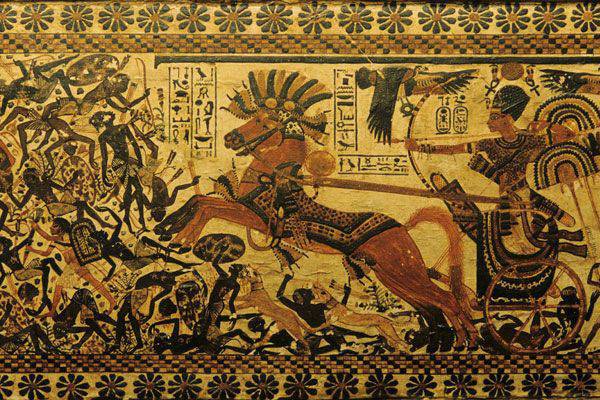
Four-legged host of the Pharaohs
The ancient Greeks called the city Kassa, the former administrative center of the XVIIth nome of Egypt, Kinopol, that is, "the dog city." In Kinopol lived a huge number of dogs that met the honor and respect of local residents. It was believed that every offender of a dog that fell into the hands of the residents of the “dog city” would inevitably be killed or, at least, severely beaten. After all, Kinopol was the capital of the cult of Anubis - the god-patron of the dead, whom the inhabitants of ancient Egypt painted in the form of a dog, a jackal, or a man with a dog or a jackal. Anubis in ancient Egyptian mythology played a crucial role - he was instructed to embalm the dead, make mummies, and also guard the entrance to the realm of the dead. As in the everyday world of dogs guarding the entrance to the dwelling of man, so Anubis in the world of shadows guarded the entrance to the abode of the dead. By the way, for some reason, dogs in many mythologies of the peoples of the world trusted to accompany human souls to the next world — such ideas prevailed not only in ancient Egypt, but also in Central America, Siberia, and the Far East. Historians believe that it was Ancient Egypt, or rather, Northeast Africa as a whole, and is the real cradle of world dog breeding. Most likely, it was here that the domestication of the first dogs took place, at least in an organized manner. After all, the farmers of ancient Egypt could not do without dogs, which were reliable defenders from the attack of wild animals.
Later, the pharaohs and grandees of ancient Egypt used dogs in their hunting games. This is despite the fact that the Egyptians tamed cheetahs, jackals and hyenas - it is obvious that the dogs were still better suited for hunting.
Most likely, it is from the jackals and originates story ancient Egyptian dog breeding. German researcher K. Keller argued that the greyhounds of ancient Egyptian pharaohs and nobles came from Ethiopian jackals who were tamed for hunting. Another German author, Richard Strebel, as a result of his research found that in Ancient Egypt there existed at least 13-15 different breeds of dogs. Their images are present on the tombs of ancient Egyptian nobles. In Egyptian culture, dogs were honored no less than in ancient Iran. Even ancient historians, including Herodotus, wrote about the great respect for the Egyptians for their dogs. Thus, in Egyptian families, following the death of a pet, mourning was inevitably declared with shaving heads and fasting. Dead dogs were embalmed in accordance with the customs of ancient Egypt and buried in special cemeteries. It is known that in ancient Egypt, dogs were used for the police service - they accompanied tax collectors and administrators who performed police functions. It is also likely that dogs took part in battles with the warriors. In the chest of Tutankhamen an image of the Egyptian pharaoh was found on a chariot, which was accompanied by dogs running alongside the chariot, biting the fallen enemy by the head.
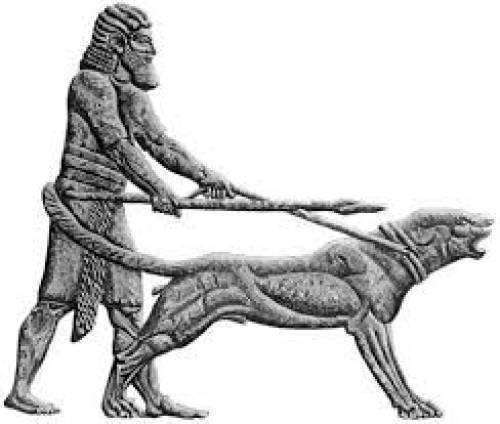
The merit of the four-legged "friends of man" was quickly enough recognized and appreciated by the inhabitants of Mesopotamia. They got notions about the fighting qualities of dogs by contacting the Iranian tribes about which we wrote above. It was with the ancient Aryans that the first fighting dogs — huge Eurasian mastiffs with great weight and excellent military characteristics — got into Mesopotamia. In Assyria and Babylonia, they began to purposely grow special breeds of dogs, the mass of which could sometimes reach at least a centner. These fighting dogs were distinguished by their aggressiveness and courage. Assyrian kings began to use dogs as present weaponby releasing them against enemy cavalry. Such a dog could eat a horse's leg, deal with a horseman. Assyrian kings fired battle dogs, clad in special armor, ahead of their battle chariots and infantry units. By the way, priests walked with the dogs, who apparently played in Ancient Assyria and the role of modern instructors - dog trainers: they were responsible for the training of dogs and could manage them during the battle. From the Egyptians and Assyrians, the Persian empire of the Achaemenids, and then the ancient Greeks, adopted the tactics of using fighting dogs in their wars. In Greece, dogs were also used to participate in battles, but even more began to be used for carrying guard and guard duty. After Ancient Rome successfully defeated the Macedonian kingdom, fighting dogs were taken prisoner along with the Macedonian king Perseus. They were led through the streets of Rome as a war trophy.
Dogs of the Celestial Empire and the Land of the Rising Sun
At the other end of the world, in East Asia, dogs also became very common as pets and as assistants in war and hunting. On the islands of the Pacific, the dog was often the only animal other than chicken and pig, which was also used as food. Only after the islands of Polynesia, Melanesia and Micronesia were colonized by Europeans, other animals appeared here, including horses and cows. The inhabitants of Eromanga Island, one of the Solomon Islands, having become acquainted with the horses and cows brought by the European conquerors, gave them names in accordance with their logic. The horse was nicknamed “smoke ivoh” - “riding dog”, and the cow “smoke matau” - “big dog”. But if in Oceania and Southeast Asia the attitude towards dogs was still primitive, in Ancient China the history of dog breeding goes back several thousand years. The attitude to the dog here was also based on local traditional myths and beliefs. For many peoples of multinational China, the dog is the most important “cultural hero”, with which even the emergence of humanity and its socio-economic progress are associated. Thus, the Yao people living in South China and the neighboring areas of Vietnam, Laos and Thailand have the myth that the Chinese emperor Kao-sin once fought a dangerous enemy.
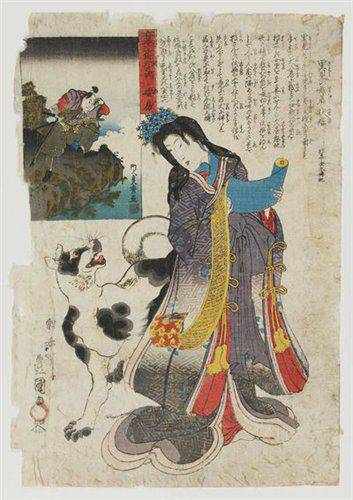 It was not possible to defeat the emperor, and he issued a decree that said: whoever brings the head of an enemy king, will receive an imperial daughter as his wife. After some time, the head of the king brought ... five-colored dog Panhu. The emperor was forced to give his daughter to marry a dog. Panhu, who had become the imperial son-in-law, could no longer remain at the court as a guard dog, and went along with the princess to southern China, where he settled in a mountainous region. Representatives of the Yao people derive their history from the descendants of the mythical marriage of the dog and the princess. Men of this nationality wear a bandage, symbolizing a dog's tail, and women's headgear includes “dog” ears as an element. The Panhu dog is still worshiped in the Yao villages, since it is associated with the spread of farming - the dog, according to legend, brought rice grains in his own skin and taught Yao to grow rice - the main food of this people.
It was not possible to defeat the emperor, and he issued a decree that said: whoever brings the head of an enemy king, will receive an imperial daughter as his wife. After some time, the head of the king brought ... five-colored dog Panhu. The emperor was forced to give his daughter to marry a dog. Panhu, who had become the imperial son-in-law, could no longer remain at the court as a guard dog, and went along with the princess to southern China, where he settled in a mountainous region. Representatives of the Yao people derive their history from the descendants of the mythical marriage of the dog and the princess. Men of this nationality wear a bandage, symbolizing a dog's tail, and women's headgear includes “dog” ears as an element. The Panhu dog is still worshiped in the Yao villages, since it is associated with the spread of farming - the dog, according to legend, brought rice grains in his own skin and taught Yao to grow rice - the main food of this people. Despite the fact that for the Chinese themselves, the “Han”, the peoples of the mountain regions remained “barbaric”, the cultural influence of their neighbors was mutual. Although the small peoples of China to a greater degree perceived elements of Chinese culture, and the Chinese themselves also perceived the individual components of the culture of their neighbors - national minorities. In particular, according to the famous ethnographer R.F. Itza - a specialist in China and Southeast Asia - the Chinese myth of Pan-gu - the first man who separated the earth from the sky - is based precisely on the ideas of the peoples of South China about the dog - the first ancestor. According to the Chinese, the dog also accompanied the person on his last journey. In Chinese mythology, as a result of the Indo-Buddhist influence, a new character appeared - the sacred lion. Since there were no lions in China, he became personified with a dog. Moreover, the ancient Chinese dogs "sunshi-tsuan" ("shaggy lions") outwardly resembled lions - it was their descendants today that spread throughout the world under the name "chow-chow". "Dog-lions" were considered the defenders of houses and temples from the possible penetration of evil spirits. By the way, it was from China that the “dog-lion” cult penetrated into neighboring Japan, where dogs were also used for hunting from deep antiquity. The first hunting society in Japan was established as early as 557 AD. In the case of the Tsinaeshi shogun, the idea of creating a dog shelter for one hundred thousand stray dogs was formulated. Perhaps humanity no longer knew such a large-scale shelter. The sensational film “Hachiko” tells about Japanese Akita Inu dogs. Hachiko's dog had been waiting for her master Professor Hidesaburo Ueno on the platform for more than nine years, who died suddenly during a lecture and, accordingly, did not return to the station from which he was accompanied daily by the dog to the train. At the station’s station, at the request of the Japanese, a monument to the dog Hachiko was erected, which deserved universal respect for its loyalty to its owner.
From Russia to Russia
Over the two millennia of its formation, the Russian civilization included not only Slavic, but also Finno-Ugric, Turkic, and Iranian components, which were manifested both in culture and in ways of doing business, and in language borrowings. For residents of forest and forest-steppe regions of Russia, the dog became an invaluable protector from wild animals, protecting the farmer’s farm from wolves and helping the hunter in search of game. In Slavic folklore, the dog became one of the main characters. The famous historian of Slavic folklore A.N. Afanasyev cites the old Ukrainian legend that Ursa Major is a harnessed horse, and the black dog every night tries to tear through the team and destroy the entire universe, but does not have time to complete its dark business before dawn and while running to the watering place, the team harness together again. Despite the adoption of Christianity, the ancient pagan ideas of the Slavs were not eliminated, moreover, the “folk religion” perfectly absorbed their components, which constituted a peculiar Christian-pagan complex of beliefs. So, the wolves were considered the dogs of St. George and it was him - the "wolf shepherd" - who had to pray for protection from the attacks of the wolves. Residents of Ukraine believed that on the eve of St. George’s Day St. George rides wolves, which is why the latter were sometimes called the “Yurov dog”. Among other beliefs - a sign about a dog howling as a messenger of the imminent death of someone from the tenants of the house or yard. Eating grass a dog indicates the rain, refusal to eat the remnants of food after a sick person - about the imminent death of the patient. The dog barking was used to determine the location of a possible betrothed: "bark, bark, my dog, where is my betrothed."
Meanwhile, the Christianization of Russia introduced a certain negative attitude to the dog. Of course, the Russians understood perfectly well that without a dog you will not manage either in hunting or in guarding business. But for Christianity, as well as for other Abrahamic religions, there was rather a negative attitude towards the dog, which was superimposed on the popular perception of this animal. There were numerous curses on the “dog's theme”, and the use of the word “dog” or “dog” to a person was interpreted solely as an insult. So, the militant neighbors of Russia began to be called dogs. These are “dogs - knights”, and Turkic-speaking nomads of the Eurasian steppes. However, the Christianization of Russia was not able to eradicate a positive attitude towards the dog, which is characteristic of the Eastern Slavs. Dog breeding has become widespread among all segments of the population. Both peasants and noble people were touched by the loyalty and loyalty of the dog, they considered the dog a reliable protector and helper. Thus, it was not by chance that Tsar Ivan the Terrible chose the head of a dog as a symbol of the oprichnina. Peasants believed that dogs would protect the house from evil spirits - devils and demons. Especially revered "four-eyed dogs", that is, dogs with brown and tan and black and tan color. By the way, the influence of Iranian mythology, in which “four-eyed” dogs are also very revered, is also noticeable here. In the end, the Russian people maintained a warmer attitude towards dogs than other neighboring nations. One of the closest neighbors of the Slavs, with whom the latter fought and traded, were the Turkic peoples of the Eurasian steppes. From their predecessors on these lands - the nomadic Iranian tribes - the Turks borrowed the attitude towards the wolf as their totemic animal. As for the dog, the Turkic nomads, on the one hand, saw in it the nearest relative of the wolf, but on the other hand, an assistant who is indispensable in cattle breeding. Indeed, without guard dogs, herds of nomads inevitably became easy prey for the same wolves. Since Russia was in close contact with the Turkic-Mongolian population of the Golden Horde, the Russian nobility gradually perceived certain features of the culture and even the ideological orientations of the steppe inhabitants. In particular, among the Russian aristocracy, dog breeding has spread under the influence of the Horde khans. When in the XV century. there was a resettlement to the Ryazan region and the Vladimir region of the Tatar Murz, along with the latter appeared their four-legged pets. The Russian boyars and even the kings themselves quickly borrowed the hunt from Tatar murzs. Virtually every boyar, and later a wealthy nobleman, sought to acquire his own kennel. The dogs became a real hobby for many landowners who, for a good puppy, were ready to give up a dozen - another peasant, or even a whole village. In the 19th century, following the trend of hunting dogs, fashion for decorative dogs appeared among the nobility, borrowed from the aristocratic circles of Western Europe. The beginning of the twentieth century. accompanied by the rapid development of dog breeding, the natural course of which, however, was disturbed by the outbreak of the First World War and the subsequent revolutions and the Civil War. In the troubled revolutionary years, people were not up to the dogs.
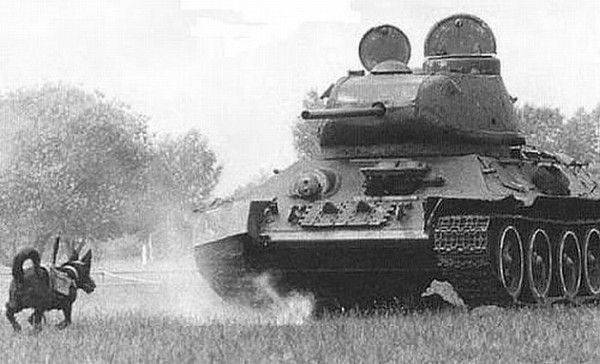
Soviet dogs: at the front and in peacetime
In the early years of Soviet power, a course was set on breeding "socially useful" dog breeds, that is, service dogs, which could be involved in law enforcement, national defense or national economy. Started the creation of clubs service dogs. 23 August 1924, the Central Training and Experimental Kennel of the School of Military and Sport Dogs was created at the Higher Shooting and Tactical School "Vystrel". This organization has become a true center for the development of service dog breeding in the Soviet Union. Here, the development of methods for training service dogs was carried out, the possible directions of their use in wartime and peacetime were analyzed. In 1927, in accordance with the order of the Revolutionary Military Council of the USSR of 5 in August, branches of communication dogs from 4 people and 6 dogs were introduced as part of the infantry regiments of the Red Army, and 29 of August of the same year issued an order to establish branches and platoons of sentinel dogs in rifle units of the Red Army. At the same time, the promotion of service dog breeding among the population of the country, above all among Soviet youth, began. In 1928, service dogs were assigned to OSOAVIAHIM. Subsequently, it was the Osoaviakhimovites who transferred to the belligerent units of the Red Army about 27 thousands of service dogs, which was an invaluable contribution to the cause of the Great Victory.
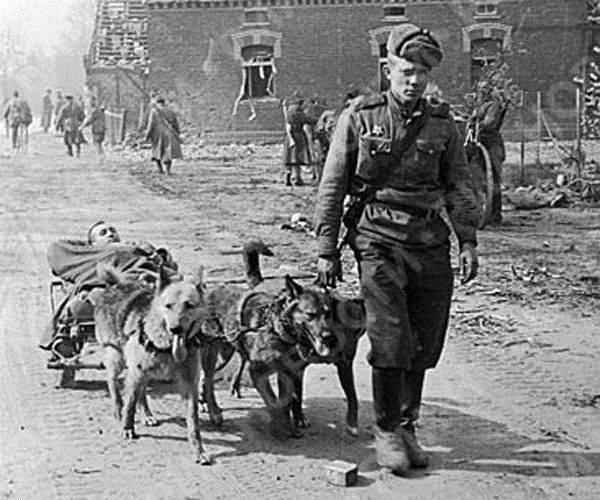
The central section of the dog service OSOAVIAKHIM of the USSR carried out serious work to popularize the service dog breeding as an important contribution to the defensive capacity of the Soviet state. Numerous circles of service dog breeding were created, in which professional trainers took part, which trained cadres of instructors of service dog breeding. It was during the interwar period that enormous work was carried out on the study of dog breeds prevalent in the USSR, including the North Caucasus, Central Asia, Siberia and the Far East. At the same time, Soviet cynologists studied the advanced experience of foreign cynology, a breed common in the United States and Europe and used for the activities of local armed forces and police forces. In 1931, on the initiative of Major General Grigory Medvedev, the Central School of the Military Dog Breeding "Red Star" was created, which, by the beginning of 1941, was training dogs in eleven types of services.
The mass use of service dogs began during the years of the Finnish War, but reached its peak in the Great Patriotic War. More than 60 thousand dogs fought in the ranks of the Red Army, among which were not only shepherd dogs, but also representatives of other very different breeds, including even large mongrels. There were 168 dog detachments, which made a huge contribution to the victory over Nazi Germany. In particular, the dogs rescued 700 seriously wounded soldiers and officers (!) Under enemy fire, discovered 4 million land mines, delivered 3500 tons of ammunition and 120 reports to the troops. Finally, at the cost of dog’s lives 300 Hitler’s tanks. Dogs checked for mines of at least 1223 sq. Km, finding 394 minefields and clearing 3973 bridges, warehouses and buildings, 33 large cities in the USSR and Eastern Europe.
In the postwar period, DOSAAF was engaged in the development of service dog breeding in the Soviet Union. In service dog breeding clubs, basic training was given to future dog handlers, who were then called up for military service in the Ministry of Defense, the Ministry of Internal Affairs, the KGB of the USSR. A large contribution to the development of dog breeding has been made by the internal affairs agencies, which dog handlers actually are on alert in peacetime, on the front lines of the fight against crime. It is the conductors of service dogs that follow the trail of lurking criminals, escort dangerous criminals, and their pets risk their lives by inspecting buildings, cars and bags of citizens for the presence of explosives and ammunition. Many breeders of law enforcement agencies today are serving in dangerous conditions in the North Caucasus. Naturally, the specifics of the activities of police canine and cynologists of other power structures require a perfect system of professional training, which allows them to cope optimally with their duties, while maintaining the safety of people, themselves and the service dog.
Rostov school service and investigative dog breeding
The Rostov School of Service and Investigative Dog Breeding of the Ministry of Internal Affairs of the Russian Federation, which was established in 1948 as a kennel for service and search dogs of the Main Directorate of Police of the Ministry of Internal Affairs of the USSR, became a unique educational institution of its kind. On the territory of the brick factory destroyed during the war on the outskirts of the city, in the village of Yasnaya Polyana, enclosures for 40 dogs, a kitchen, a maternity room and a room for puppies were placed. Initially, the staff of the kennel consisted of 12 employees - three instructors and nine handlers of search dogs. In 1957, the Training Center of the Police Department of the Ministry of Internal Affairs of the RSFSR was created here, where the training of handlers of search dogs began at a three-month course designed for 50 students. Two barracks, headquarters and club buildings were built.
In 1965, a training course for service-searching dogs was also relocated from Novosibirsk to Rostov-on-Don, after which the Training Center was reorganized into the Rostov school of junior commanding staff of the USSR Ministry of Internal Affairs. 125 cadets have already been trained here, and the duration of training has been increased to nine months. In addition to canine disciplines, future conductors of service-searching dogs also began to study the basics of operational-search activity, to improve their combat training. In 1974, the school was reorganized into the Central School for the Improvement of Workers of the Investigative Dog Service of the Ministry of Internal Affairs of the USSR, and in 1992 in the Rostov School of Service and Search Dog of the Ministry of Internal Affairs of the Russian Federation.
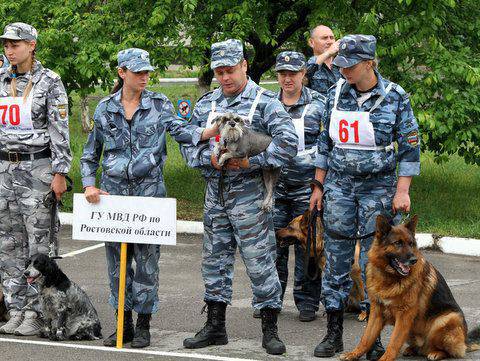 Currently, more than 300 students from all over the country are trained at the Russian School of Internal Affairs at the Ministry of Internal Affairs. This is really a unique and best educational institution, whose graduates continue to serve not only in the bodies of the Ministry of Internal Affairs of the Russian Federation, but also in other power structures of the country. Teaching at the school is carried out by brilliant experts in their field, who have more than one year of service in law enforcement agencies. Many of them participated in the aftermath of emergency situations, ensuring the safety of citizens during public events, took part in hostilities during the counter-terrorist operation in the North Caucasus. The popularity of the knowledge that is given in school is evidenced by its popularity outside our country. Thus, at different times, students from Algeria and Afghanistan, Bulgaria and Vietnam, Mongolia and Palestine, Nicaragua and Sao Tome and Principe, Syria and DPRK, Belarus and Armenia, Uzbekistan, Tajikistan, Kyrgyzstan and a number of other states were trained at school. They subsequently successfully acquired the acquired knowledge in the service in the law enforcement bodies of their home countries.
Currently, more than 300 students from all over the country are trained at the Russian School of Internal Affairs at the Ministry of Internal Affairs. This is really a unique and best educational institution, whose graduates continue to serve not only in the bodies of the Ministry of Internal Affairs of the Russian Federation, but also in other power structures of the country. Teaching at the school is carried out by brilliant experts in their field, who have more than one year of service in law enforcement agencies. Many of them participated in the aftermath of emergency situations, ensuring the safety of citizens during public events, took part in hostilities during the counter-terrorist operation in the North Caucasus. The popularity of the knowledge that is given in school is evidenced by its popularity outside our country. Thus, at different times, students from Algeria and Afghanistan, Bulgaria and Vietnam, Mongolia and Palestine, Nicaragua and Sao Tome and Principe, Syria and DPRK, Belarus and Armenia, Uzbekistan, Tajikistan, Kyrgyzstan and a number of other states were trained at school. They subsequently successfully acquired the acquired knowledge in the service in the law enforcement bodies of their home countries. In addition to training activities, scientific work is also carried out in the Rostov school of service-search dog breeding, including scientific conferences devoted to various topical aspects of modern cynology. Only in the last five years, the school has issued 10 educational and teaching aids, and since 2010, the magazine Profession - Dog Handler has been published. Much work is being done in the field of veterinary research: school employees study the effect of altitude changes on the general health and performance of working dogs, determine the possibility of using high-calorie food to improve the cardiovascular system of working dogs, analyze the specificity of using antioxidants to overcome the biological barriers of adaptability and improve the performance of the sensory systems of service dogs. It has become a tradition to hold interdepartmental competitions on the school’s territory, in which cynological experts from various departments of the South of Russia take part, including both police officers and the Federal Customs Service, the Federal Drug Control Service, and the Federal Penitentiary Service. Moreover, graduates and students of the school often take prizes in competitions. They are readily recruited in any cynological profile structure.
- P P 'SЊSЏ RџRѕR "RѕRЅSЃRєRёR№
- the press service of the Ministry of Internal Affairs of the Rostov region
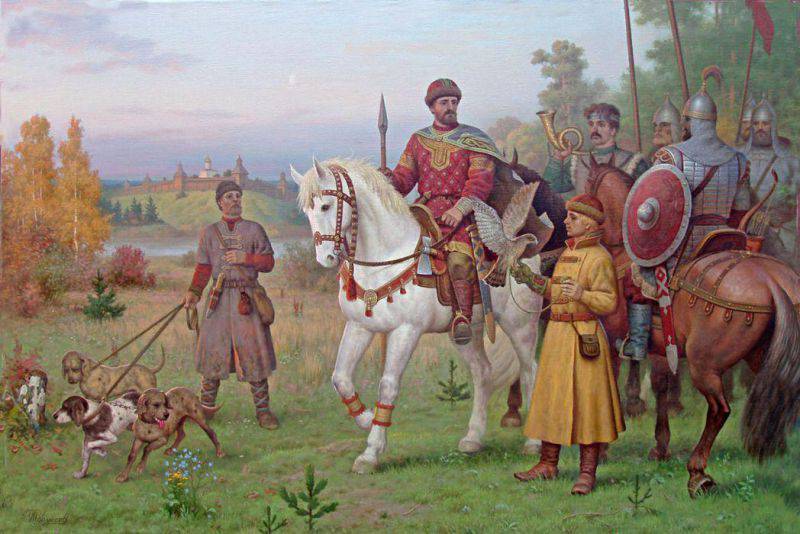
Information